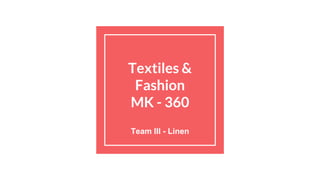
Linen Fiber: From Flax to Fabric
- 1. Textiles & Fashion MK - 360 Team III - Linen
- 2. How Flax is made into Linen: https://youtu.be/HCJQCWDIozk Cellulosic, Protein, or Petrochemical? Flax also known as common flax or linseed),with the binomial name Linum usitatissimum Linen is a cellulosic fiber to produce this material fiber is obtained from the inside stalk of the flax plant. Flax is an annual plant, which means it only lives for one growing season. From the time that the seed is planted, it is ready to be harvested in about a hundred days. Flax requires little watering or attention during this time. It grows to about three or four feet tall, with glossy bluish-green leaves and pale blue flowers. When it is harvested the seeds are cultivated for replanting for the next set of crops. Other cellulosic fibers include cotton and bamboo.
- 3. Basic Characteristics (B) What are the basic characteristics of the fiber, which is covered in Chapter 4. ● “Linen yarns are classified into two types called tow and line. Tow linen is composed of short fibers and is irregular and rather coarse in texture. Tow linen is used for coarser types of linen fabrics found in sports jackets and trousers. Line linen is composed of long fibers averaging about 15 inches (38.1 centimeters) in length. Line linen yarns are smooth and fine and are used for fabrics such as fine table linens and tissue-weight blouses.” - Page 72 ~ ~ ~ ~ ~ ● Linen can absorb a fair amount of moisture without feeling unpleasantly damp to the skin, unlike cotton. It is a very durable, strong fabric, and one of the few that are stronger wet than dry. The fibers do not stretch, and are resistant to damage from abrasion.
- 4. Basic Characteristics ~ Physical PropertiesPhysical Properties of Linen: 1. Tensile Strength: Linen is a strong fiber. It has a tenacity of 5.5 to 6.5 gm/den. 2. Elongation at break: Linen does not stress easily. It has an elongation at break of 2.7 to 3.5%. 3. Color: The color of linen fiber is yellowish to grey. 4. Length: 18 to 30 inches in length. 5. Lustre: It is brighter than cotton fiber and it is slightly silky. 6. Elastic Recovery: Linen fiber does not have elastic recovery properties. 7. Specific Gravity: The specific gravity of linen fiber is 1.50. 8. Moisture Regain (MR %): Standard moisture regain is 10% to 12%. 9. Effect of Heat: Linen has an excellent resistance to degradation by heat. It is less affected than cotton fiber. 10. Effect of Sun Light: Linen fiber is not affected by the sunlight as others fiber are.
- 5. Basic Characteristics ~ Advantages ● Excellent strength; gains strength when wet ● Hydrophilic: Absorbs water and dries quickly ● Cool in warm weather ● Washable ● Withstands very high temperatures when washing and ironing ● No static, pilling, or lint problems ● Unique texture from the thick-and-thin pattern of the fibers
- 6. Largest Producing Countries & Annual Production 1. Canada - 368,300 tons 2. Russia - 230,000 tons 3. Ukraine - 51,100 tons “Russia produces the most, but Belgium produces the best.” Countries from http://textilefashionstudy.com/top-flax-growing- countries-of-the-world-linen-fiber-production/
- 7. Production Continued Linen Production in Europe “The best quality linen is retted in slow-moving natural water sources such as streams and rivers” Top Quality: Western Europe and The Ukraine Bulk: Eastern Europe and China http://www.decktowel.com/pages/how- linen-is-made-from-flax-to-fabric
- 8. Main End Uses What are the main end uses for this fiber? Apparel: Suits, jackets, skirts, and dresses. ● Interior: Tablecloths, napkins, and wallpaper.
Editor's Notes
- Flax is one of the oldest cultivated plants in history. It is cultivated around the world for both it’s fine, strong fibers, and also for its seeds, which are rich in nutrients such as dietary fiber and omega-3 fatty acids. Flax oil is also a popular drying oil amongst oil painters. The flax type tends to grow taller, more slender, and with less branches. It is cultivated in order to extract the very long fibers from inside the wooden stem of the plant, which are then spun and woven into linen fabric. The taller the flax plant, the longer the fiber. http://purelinenblog.blogspot.com/2013/03/source-of-linen_15.html http://www.decktowel.com/pages/how-linen-is-made-from-flax-to-fabric